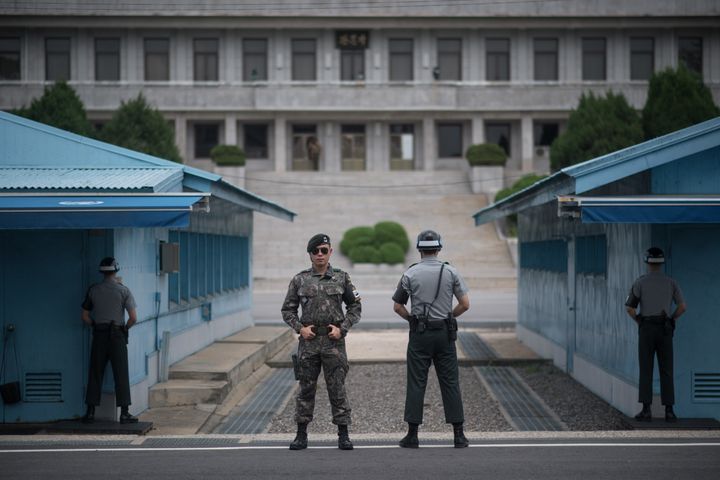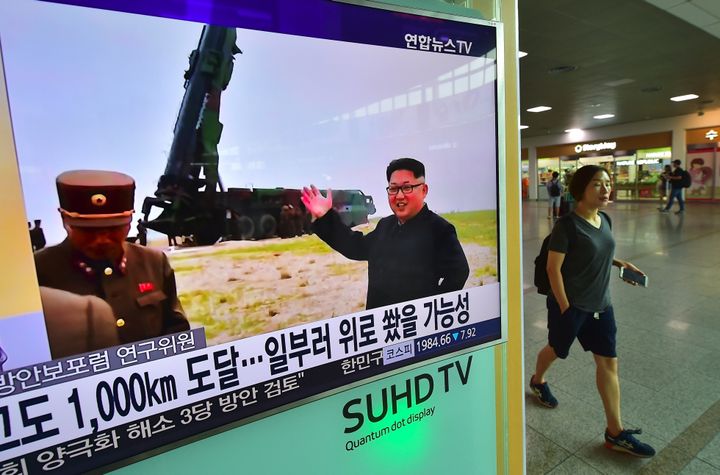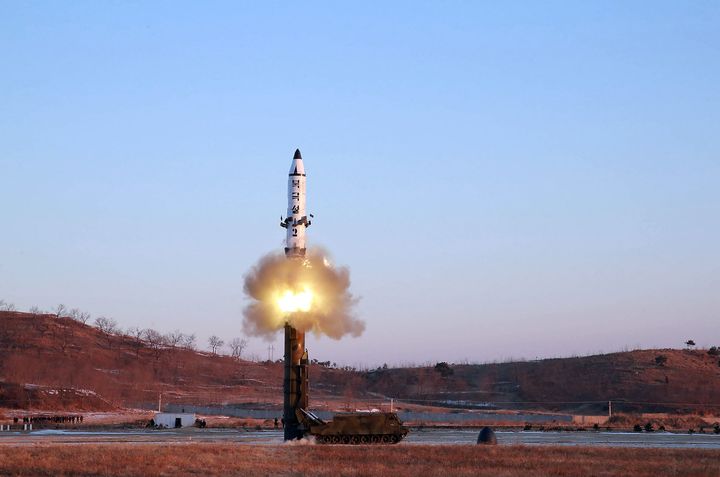No doubt if you’ve seen the news today or ventured onto social media you’ll have noticed the world appears to be slightly more... apocalyptic today.
Fraught fears of a fiery and agonising death as the nuclear tensions between North Korea’s Kim Jong-un and President Trump are at the forefront of many people’s minds - albeit in a surprisingly upbeat manner.
The two leaders are locked in an escalating war of words with the Trump’s threat of “fire and fury” being returned with a claim the dictatorial state is “examining the operational plan” to strike areas around the US territory of Guam.
But should you actually worry?
Secretary of State, Rex Tillerson, just said everything is fine and no one should let it interrupt a good night’s sleep.
But seeing as Tillerson works for one of the two men at the forefront of this whole crisis, we went elsewhere for an opinion.
A Expert’s View From South Korea
A North Korean attack or an American pre-emptive strike is unlikely, said John Delury, an associate professor of East Asian Studies at Yonsei University in Seoul.

Delury saw North Korea’s statement as a warning to Washington that its missiles could reach targets in the region, rather than one of an actual attack, reports the Associated Press.
“Well, I’m gonna go out on a limb here and say if North Korea was planning some kind of pre-emptive or surprise attack on Guam, we would not be reading about it in North Korean media,” he said. “Now that said, you do need to track their threats. And there are cases where they (have) made a specific threat and carried it out.”
A US strike against North Korea would need the support of South Korea, he said, because the North would likely retaliate against the South and its 600,000 troops.
North Korea has artillery placed along the border with its southern neighbour that could bombard Seoul with devastating results.
“It’s not something you can do without robust, full support from the South Korean government people, and there’s absolutely no sign that South Korea will support military options [against] North Korea,” Delury said.
Phew, that’s a relief. But what about if Trump keeps making statements that sound like they’re coming from the Book of Revelations?
A Expert’s View From China
Chinese government-backed scholars said Beijing is deeply concerned about the latest statements from Trump and North Korea. They hold the US partly responsible, saying Trump’s heated rhetoric is fuelling the flames.

Trump’s tough talk has contributed to an increase in animosity that is pushing the sides closer to armed conflict, said Cheng Xiaohe of the School of International Studies at Beijing’s Renmin University.
“If not kept well under control, this verbal spat could turn into a military clash,” he said, adding that China should dispatch diplomats to engage in shuttle diplomacy to bring the sides to the negotiating table.
China’s patience with North Korea, its onetime close ally, appears to be running thin: Beijing agreed to recent UN sanctions, despite potential losses to Chinese firms doing business with North Korea and fears over destabilising the Pyongyang regime.
A top Chinese expert on North Korea said Pyongyang seemed to have been heartened by Washington’s failure to take firm measures in response to earlier actions.
“Trump said the US would take tough measures if North Korea fired off missiles, but it did not,” said Zhang Liangui, a professor at the ruling Communist Party’s main training academy. “This might make North Korea think that’s just some verbal threat, so its attitude is getting tougher and tougher.”
The US, China and Russia need to come together to force the North to de-escalate, he said. “The big countries should not attack each other, but unite to better cooperate on maintaining the denuclearisation of the Korean Peninsula.”
OK, that’s slightly less comforting but is North Korea even capable of sending us all to a fiery grave?
An Expert’s View From The USA
US nuclear expert Siegfried Hecker, who has repeatedly visited North Korea’s nuclear facilities, said he doesn’t think North Korea currently has weapons systems for “enveloping fire” around Guam, as it threatened.

“I don’t believe they have the capability to do so yet, and besides, why would they want to commit suicide by attacking a remote target like Guam?” he said.
“The real threat is stumbling into an inadvertent nuclear war on the Korean Peninsula by misunderstanding or miscalculation. Inflammatory rhetoric on both sides will make that more likely. It’s time to tone down the rhetoric.”
Hecker said North Korea does not have a sophisticated nuclear weapon like those of the US, Russia, Britain, China or France, the major nuclear superpowers.
“The shorter-range missile that can reach South Korea and Japan can accommodate larger nuclear warhead payloads,” he said. “Making the warhead sufficiently small, light and robust to survive an ICBM delivery is extremely challenging and still beyond North Korea’s reach.”
The way to avert a war with North Korea is to have a conversation, and that’s not happening, Hecker said.
“Unfortunately, there seems to be no serious dialogue between Washington and Pyongyang, only threats,” he said.
So in conclusion, despite North Korea’s threat to attack Guam, it appears extremely unlikely that its leadership would risk its own destruction with a pre-emptive attack on the American territory.
Professor Christophe Bluth, Professor of International Relations and Security at the University of Bradford summed it up: “North Korea is focused on regime survival. While they use military threats in their diplomacy, they understand the limits because any major war would end the regime.”
The Technical Stuff
If the worst does happen, armed with the following knowledge at the very least you’ll have the satisfaction of being able to spot which type of missile is responsible for your demise.
Analysts believe North Korea does have several missiles in its arsenal capable of reaching the Pacific island, which Pyongyang has regularly threatened because of its US military bases.
What’s much less certain, however, is whether the North’s missiles can inflict serious damage once they reach Guam, located about 3,400 kilometers (2,100 miles) from the Korean Peninsula.
Those missiles have never been used in combat situations and have had relatively few test flights. It’s also unclear whether North Korea has mastered the technology needed to protect the missiles from extreme heat and pressure upon atmospheric re-entry so they can hit the intended target.
With those caveats, a look at some of the missiles possibly capable of reaching Guam:
HWASONG-12
The North Korean army’s statement Wednesday that it plans to create an “enveloping fire” in areas around Guam are based on the Hwasong-12, a new intermediate range missile the country successfully flight-tested for the first time in May.

The liquid-fuel missile is designed to be fired from road mobile launchers and has been previously described by North Korea as built for attacking Alaska and Hawaii. The North followed the May launch with two flight tests of its Hwasong-14 ICBM last month. Analysts said that a wide swath of the continental United States, including Los Angeles and Chicago, could be within reach of those missiles, once perfected.
The flight data from the May launch suggested Hwasong-12′s range was between 4,000 and 7,000 kilometers (2,500 and 4,350 miles.
MUSUDAN
Analysts say the liquid-fuel Musudan missile’s potential 3,500-kilometer (2,180-mile) range puts much of Asia and the Pacific within reach. North Korea experienced several failures before a successful flight test in June last year, after which the country’s leader, Kim Jong Un, declared that his nation had the “sure capability to attack in an overall and practical way the Americans in the Pacific operation theater.”

Before last year’s launches, North Korea had never flight-tested a Musudan missile, although one was displayed during a 2010 military parade in Pyongyang.
PUKGUKSONG-2
A land-based variant of a submarine-launched missile currently under development, North Korea first successfully flight-tested this solid-fuel midrange missile in February. Three months later, Kim declared the missiles ready for mass production after another successful test.

Analysts say the Pukguksong-2 advances North Korea’s weapons capabilities because missiles using solid propellants can be fired faster and more secretly than those using liquid fuel, which must be fuelled before launch and transported to a launch site using trucks that could be spotted by satellites.
North Korea describes the Pukguksong-2 as a “medium-to-long range strategic missile,” the same term it uses for the intermediate range Hwasong-12, and some South Korean experts see the missile as potentially capable of reaching Guam. But South Korean defense officials said after the May launch that they estimated Pukguksong-2′s range to be around 2,000 kilometers (1,242 miles), which would be enough to strike US bases in Japan but come short of reaching Guam.
LATEST: Trump Isn’t Backing Down
UPDATE:
In more positive news, North Korea has released a long-held Western political prisoner, Canadian pastor, Hyeon Soo Lim.
